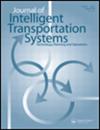行动不便者交通模式检测框架
IF 2.8
3区 工程技术
Q3 TRANSPORTATION
Journal of Intelligent Transportation Systems
Pub Date : 2025-09-03
DOI:10.1080/15472450.2024.2329901
引用次数: 0
摘要
交通模式检测(TMD)是一项重要的计算技术,可在社会和个人层面帮助人类生活。然而,以往关于 TMD 的研究主要集中在没有...本文章由计算机程序翻译,如有差异,请以英文原文为准。
A framework of transportation mode detection for people with mobility disability
Transportation mode detection (TMD) is an important computational technique that aids human life at the social and individual levels. However, previous studies on TMD were focused on people without mobility disabilities, and research involving people with mobility disability is limited. Therefore, this study aimed to provide a TMD framework for people with mobility disability. We propose a method for data acquisition, and acquired data pertaining to 120 participants including manual and electric wheelchairs for 15,350 min. We analyzed the acquired data to determine the characteristics of each transportation mode, and applied machine learning and deep learning models to TMD. Our results showed that a recurrent neural network, known as long short-term memory, could classify five transportation modes (still, manual wheelchair, electric wheelchair, subway, and car) for people with and without disabilities, with an accuracy of 96.17%. Our results will be beneficial for enhancing the quality of life and enabling the social inclusion of people with mobility disabilities.
求助全文
通过发布文献求助,成功后即可免费获取论文全文。
去求助
来源期刊
CiteScore
8.80
自引率
19.40%
发文量
51
审稿时长
15 months
期刊介绍:
The Journal of Intelligent Transportation Systems is devoted to scholarly research on the development, planning, management, operation and evaluation of intelligent transportation systems. Intelligent transportation systems are innovative solutions that address contemporary transportation problems. They are characterized by information, dynamic feedback and automation that allow people and goods to move efficiently. They encompass the full scope of information technologies used in transportation, including control, computation and communication, as well as the algorithms, databases, models and human interfaces. The emergence of these technologies as a new pathway for transportation is relatively new.
The Journal of Intelligent Transportation Systems is especially interested in research that leads to improved planning and operation of the transportation system through the application of new technologies. The journal is particularly interested in research that adds to the scientific understanding of the impacts that intelligent transportation systems can have on accessibility, congestion, pollution, safety, security, noise, and energy and resource consumption.
The journal is inter-disciplinary, and accepts work from fields of engineering, economics, planning, policy, business and management, as well as any other disciplines that contribute to the scientific understanding of intelligent transportation systems. The journal is also multi-modal, and accepts work on intelligent transportation for all forms of ground, air and water transportation. Example topics include the role of information systems in transportation, traffic flow and control, vehicle control, routing and scheduling, traveler response to dynamic information, planning for ITS innovations, evaluations of ITS field operational tests, ITS deployment experiences, automated highway systems, vehicle control systems, diffusion of ITS, and tools/software for analysis of ITS.

 求助内容:
求助内容: 应助结果提醒方式:
应助结果提醒方式:


